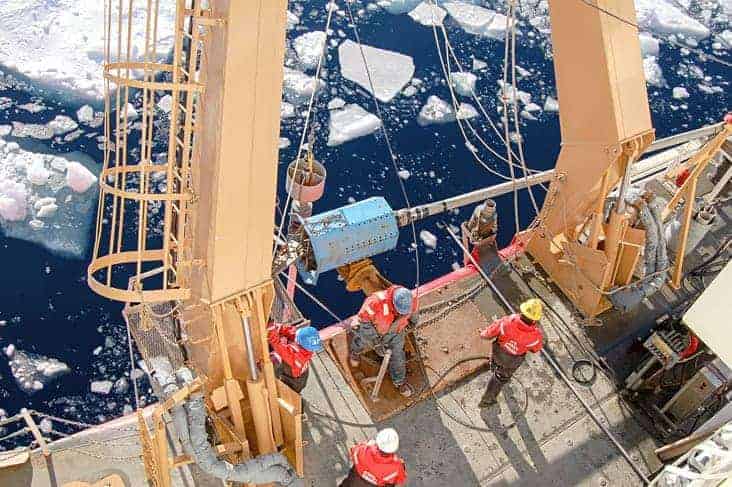An American research team found the fingerprint of a massive flood of freshwater in the western Arctic that they say likely caused an ancient cold snap 13,000 years ago.
The cold snap is known as the Younger Dryas, which ended more than 1,000 years of warming, said Lloyd Keigwin, an oceanographer and lead author of the study.

“How exciting it is when the pieces of a more than 100-year puzzle come together,” said Keigwin. “It's kind of an exciting story because it's a long-standing puzzle, what caused the Dryas and what happened to the water diverted from the Gulf of Mexico 13,000 years ago,” he said.
The paper, published in Nature Geoscience, says the source of the cooling was an “influx of freshwater from melting ice sheets and glaciers that gushed into the North Atlantic,” disrupting deep-water circulation patterns, a news release state.
The study suggests floodwaters travelled north along the Canadian Archipelago, the group of islands north of the Canadian mainland, through the Fram Strait between Greenland and Svalbard, and to the Nordic Seas north of Iceland.
For 30 years, Keigwin searched for scientific markers that freshwater travelled through an eastern corridor.
With two miles of ice at maximum glaciation, water outflows were blocked by ice in the easterly outlets and bled into the Mississippi.
“People suspected an outflow of flooding freshwater that could have gone eastward, but there were suspicions that it could have been directed out the Mackenzie,” he said.
Unable to find the specific biological fingerprint in the east, researchers turned their attention to the North in search of a specific oxygen isotope (atoms with the same number of protons, but different numbers of neutrons). The isotope is a common marker in other cooling events, he said.
The researchers sailed the U.S. Coast guard cutter Healy through the eastern Beaufort Sea collecting evidence of the suspected flood at the confluence where the mighty Mackenzie River flows into the Arctic Ocean.
The research team from Woods Hole Oceanographic Institution (WHOI) had researchers from the University of California San Diego and Oregon State University. The study was funded by the National Science Foundation with cooperation from Canada's federally funded Bedford Institute of Oceanography and the Canadian Geological Survey.
The team gathered sediment cores along the slopes of the Mackenzie River, but cored from Barrow, Alaska to the Amundsen Gulf.
The researchers analyzed fossilized plankton in the sediment cores for the scientific clue that the region was at one time inundated with freshwater.
They found the biological fingerprint appeared in the shells preserved in sediment.
“It's the only place that we've seen that signal similar to what used to go out the Mississippi,” he said.
“It had to be greater than the Mississippi, and possibly even as large as the Amazon. For some relatively short amount of time the Mackenzie was probably the biggest river in the world,” said Keigwin.
The researchers used carbon dating – a method of studying carbon to determine the age of organic matter. They used circulation models to determine that the low-salinity surface water was transported to the North Atlantic, disrupting the Atlantic Meriodional Overturning Circulation, a large system of ocean currents that carry warm water from the tropics to the North Atlantic.
Naysayers will point to the delicate process of carbon-dating as a possibly uncertainty for the date, said Keigwin, but the isotope identifier has a high “signal to noise ratio.”
“The data are robust, the biggest uncertainty is in the timing. (Some scientists) want it to be younger, but it occurs at the right time. There are still people who are going to say 'No, no, no, it had to go down the St. Lawrence' and they aren't oceanographers who recognize the significance of the isotope,” he said.
Keigwin says he hopes the paper's findings will prompt additional research on how much freshwater could trigger cooling.
“We've known for maybe 25 years that there were times in the recent past – which to a geologist would be the past 20,000 years – that there were times when the climate got unexpectedly cold,” he said.
“There were discussions of armadas of icebergs that floated into the North Atlantic. It was thought that somehow the freshwater had interrupted the overturning of waters,” he said.
The low-salinity freshwater would have frozen near sites of deep-water formation, suppressing the convection of water overturning in the Northern seas, said Keigwin.
It's for that reason that in today's climate, at the same latitude as Oslo, North of 60, Greenland at the same latitude is comparatively “frozen and desolate,” he said.
“Everything we do in a closed system like planet Earth can have unintended consequences. The climate system is very sensitive to fresh water so we have to be careful about our ice caps.”
“After not understanding the origin of this cold event for more than 100 years we finally have a handle on it,” he said.